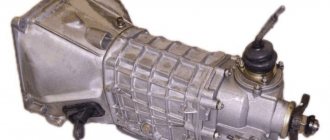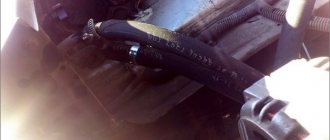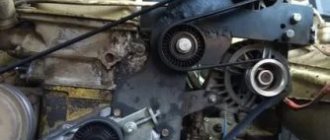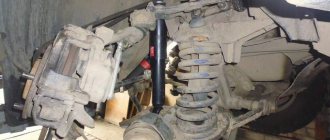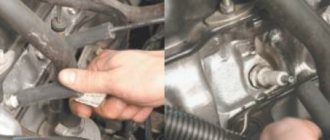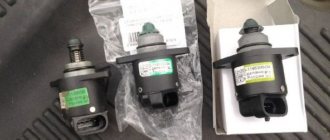The Chevrolet Niva SUV is equipped with two types of engines – Opel’s 1.8-liter Z18XE and the 1.7-liter VAZ-2123. If the Opel engine does not cause car owners virtually any problems, then various problems occur with the VAZ power unit.
Niva Chevrolet hydraulic compensators often cause trouble for car owners - valves knock, the engine begins to work intermittently.
Description of the hydraulic compensator device and its principle of operation
Hydraulic compensators are designed to automatically regulate the thermal gap between the valves and the engine camshaft. The hydraulic attachment is provided by oil, which enters the expansion joints under pressure, and a complex and incredibly precise set of springs provides the necessary clearance.
Hydraulic compensators, which have been installed on Chevrolet Niva in recent years, give them a tangible advantage:
- there is no need to periodically adjust the valves;
- now the timing belt works more clearly and correctly;
- The noise when the engine is running has decreased significantly; it begins to knock less;
- The service life of timing parts has increased significantly.
Main details of the unit:
- Plunger pair.
- Frame.
- Plunger bushing.
- Plunger spring.
- Plunger ball valve.
The operating principle of the unit is relatively simple and consists of three main functions:
- There remains a small gap between the camshaft cam and the compensator, which is filled with oil. The plunger spring pushes the plunger out of the sleeve, the oil fills the gap under pressure, reaches the desired level, and the ball valve shuts off the oil supply. After these actions, the gap disappears.
- By turning, the cam moves the compensator down. Due to the accumulated oil, the plunger pair becomes rigid and presses on the valve, opening it.
- As the plunger moves down, it loses some oil and its pressure drops. As the cam moves further, the cycle repeats.
Design of hydraulic compensators on Niva Chevrolet
As you know, on standard or, more simply put, “classic” VAZ engines, rockers were mounted in the gas distribution mechanism, and valve clearances were adjusted with special screws.
However, on the 2123 engine for Niva Chevrolet, hydraulic compensators are provided, made in the form of exactly the same adjustment bolts, and the gaps are adjusted due to the operation of the plunger pair and the required oil pressure in the engine.
Despite the apparent complexity of the design, the structure of the engine is very simple and consists of only four parts:
- Hydraulic compensator housings.
- Return spring.
- A plunger pair, or rather, of its two parts, upper and lower, that is, a plunger and a check valve with a piston.
Why do valves start knocking?
Among all the possible reasons why valves on a Chevrolet Niva start knocking, it is necessary to highlight the main ones:
- Insufficient system oil pressure.
- The oil channels in the engine are dirty, and this causes intense contamination of the entire lubrication system.
- The lubricant level in the system is insufficient.
- The seat for the hydraulic compensator is worn out.
- The parts and components of the hydraulic compensators are worn out.
It happens that hydraulic compensators begin to knock immediately after starting in cold weather, and literally immediately after 30–60 seconds it goes away. This is explained by the fact that the oil arrives to the hydraulic compensators late and does not have time to provide them with the required amount of lubricant.
This problem can be solved after the oil and oil filter are replaced. And when the valves knock when the engine is “hot”, a regular oil change is no longer enough; you will have to remove the “head”, the camshaft and clean the channels. If this procedure does not bring any results, you will have to change the hydraulic compensators.
Please note that valve knocking caused by hydraulic compensators can have the following consequences:
- There is wear on the camshaft cams.
- Rocker surfaces will show severe wear
- Valve stem wear.
Driving for a long time with such a “knock” is highly not recommended, because it directly affects the wear of the timing mechanism parts, fuel consumption will increase and power will decrease.
What to choose, hydraulic compensators or adjusting bolts?
Hydraulic compensators installed from the factory are not always of high quality, because they can knock almost immediately when the car comes off the assembly line, having a very short mileage. As practice shows, the cause of this problem is the insufficient force with which the bolt was tightened at the factory, and this is 2–2.2 kgf . However, if these parts are no longer functional, then you have to choose what to replace them with, fortunately there are options.
The highest quality and most reliable hydraulic compensators on the market are considered to be “INA” products from the German company of the same name. But AvtoVAZ also produces products in the budget segment (its range includes products of both old and new types, distinguished by cylinder heads that were modernized after 2008 - approx.).
If you ask the question of what to choose, then you will have to be guided primarily by the price. Hydraulic compensators, as a rule and most often, are sold individually with a price ranging from 350 to 500 rubles, and the adjusting bolt barely exceeds 50. If you are ready to adjust the valves every 10-15 thousand kilometers, then the second option will be preferable to you, because there are no problems they cost less, and repairs and maintenance are cheaper.
Types of hydraulic compensators
At the beginning of the production of Chevrolet Niva cars, old-style compensators were installed, and in the fall of 2008, a modified, new version of this part began to be installed.
Hydraulic compensators Niva Chevrolet old model
Until 2005, General Motors supplied its own expansion joints, which were of impeccable quality. But then the domestic “hydriki” came along, and the problems began. The quality of the supplied parts left much to be desired; the metal from which the parts were made was raw and did not have a long service life.
New Generation
The end of 2008 was marked by the appearance of a new generation of hydraulic compensators among Chevrolet Niva assemblers. At first, about two years, there were no problems, the parts were of good quality, the metal was hardened and wear-resistant. And then the same story began as with the old ones - the glasses became “half-baked” and could not serve their owners for a long time.
Depending on the design of the timing mechanism (gas distribution mechanism), several types of hydraulic compensators are distinguished:
- hydraulic pushers;
- roller hydraulic pushers;
- hydraulic supports;
- hydraulic supports, which are installed in rocker arms or levers.
How to identify a faulty hydraulic compensator
To determine a knocking compensator, you need to use a screwdriver, which is used as a lever, to press on those “hydraulics” that are at TDC (top dead center). If the hydraulic compensator fails under pressure from a screwdriver, it means it is not adjusted. If you want to make sure of this, quickly press with a screwdriver and you will hear a characteristic sound.
Typical faults
Problems with hydraulic compensators arise for two reasons. It is not difficult to identify them - this is either a mechanical breakdown of the unit itself, its destruction, or a breakdown of the oil supply system to the compensator.
In the first case, a common cause is wear of the plunger pair. This is an inevitable process that depends only on the operating time of the unit and the quality of the metal from which it is made. Factory defects cannot be ruled out; this is extremely rare, but it does happen. Replacing this part costs the same as replacing a regular consumable.
In the second case, the oil level in the engine matters; it can be too low or too high. The oil filter may be dirty and dirt may have entered the channels. Untimely oil change is another reason for unstable operation of the unit.
Do not forget about the correct selection of oil - use oils of the same type and preferably from the same manufacturer. The consequences of failure to comply with these rules can be disastrous; saving on oil can cost you money to repair the engine.
Causes of knocking hydraulic compensators
The knocking sound of Chevrolet Niva hydraulic compensators can be easily detected by ear; it knocks at a frequency half the engine speed. It can knock both on a cold engine and on a hot one, and the reasons for this are different.
Reasons for knocking when cold:
- Thick oil. As the engine warms up, the oil heats up, becomes thinner, and the knocking noise goes away.
- Dirt. A bad filter or old oil can cause dirt to get into the channels and holes and clog them.
- Worn or broken plunger. The cause may be natural wear or abrasive contaminants that have entered the oil.
"Hot":
- Plunger jamming. Scuffing on the plunger pair increases its wear significantly and blocks it.
- Oil with incorrect viscosity. When changing the oil seasonally on their own, sometimes owners make mistakes and fill in oil with the wrong viscosity. If it is too liquid, it quickly flows out through those. gaps.
- Increased oil level in the engine. If this is due to coolant getting into the oil, it will foam in contact with the crankshaft.
All these reasons can be eliminated yourself if you carefully monitor your car.
Replacing hydraulic compensators on a Chevrolet Niva with your own hands: video
The Russian SUV Chevrolet Niva was initially equipped with two types of engines - a VAZ-2123 with a volume of 1.7 liters, and a Z18XE from the German company Opel with a volume of 1.8 liters. If the latter is installed on your car, then, as a rule, it does not cause any hassle or problems, but with the Russian analogue everything is much more complicated, since the valves periodically begin to knock, forcing the engine to work intermittently, requiring replacement of the hydraulic compensators.
The video shows a search for faulty hydraulic compensators on a Niva Chevrolet
Below in this article we will look at why this happens, how to replace them correctly, and also share some tips on the correct installation of such spare parts.
Step-by-step procedure for replacing hydraulic compensators
If it is not possible to eliminate the knocking of hydraulic compensators using all the above methods, then it is necessary to replace it, and how to do this correctly, read below in our article.
- Place the car on a level surface, turn on the handbrake and neutral gear.
- Next, open the hood and first remove the air duct.
- Then we free the valve cover from all kinds of pipes by unscrewing the clamps from them.
- Remove the eight bolts from the valve cover.
Removed the valve cover. - Next, place a mark on the camshaft, with a mark on the back of the gear.
- The sprocket bolt must be loosened and the chain tensioner removed.
When removing the bolt, keep the sprocket and chain motionless. - The above-mentioned tensioner can be immediately “recharged” by sinking it into the plunger and securing it with a nut and cap.
The order in which the bolts are removed does not matter. - Continuing dismantling, unscrew all the nuts that secure the camshaft, and then remove it.
Down with the camshaft. - Then we take out all 8 rockers and dismantle the expansion joints.
Only after this work can you proceed to dismantling the hydraulic compensators.After dismantling, put the parts aside.
- In their place we install new parts, tightening them with a force of 2 kgf, using a special key, and if it is missing, quite firmly, but without over-tightening or leaving them too loose.
- We continue the installation by installing the rockers again in their places.
- Then we make marks and mount the camshaft in its place.
- When it is installed, we fix it in place, and also install the sprocket and chain tensioner.
We install the previously fixed chain. - Before tightening the chain, we look at the coincidence of all the marks again and finally fix it with a nut for tensioning the chain.
- We mount the valve cover in place and connect all the pipes (pay attention to the condition of the pipes and clamps, because if there is a strong degree of wear, it is best to replace them - approx.).
- We start the engine and observe the result. Please note that at the first start there may still be the same knocking noise, however, as soon as they are filled with oil, it should stop and engine operation will return to normal.
At this point, the work on replacing hydraulic compensators can be considered completed.
Tips for replacing hydraulic compensators
Hydraulic compensators for "Shniva" close up.
If you hear valve knocking, do not rush to replace the hydraulic compensators; try changing the engine oil first.
- Fill in high quality oil with a viscosity of 10W40 in summer, and 5w30 or 0w30 in winter. Please note that if the same oil is constantly poured and changed on time, i.e. every 7-10 thousand kilometers, then the fact of clogging of hydraulic compensators is significantly reduced.
- If you have dismantled the hydraulic compensators, try washing them in gasoline after disassembling them. After cleaning, check their functionality by pressing the plunger with your finger, and if it is working, it will return to its original position.
Video about washing hydraulic compensators on a Chevrolet Niva
Design of hydraulic compensators on Niva Chevrolet
Up close.
As you know, on standard or, more simply put, “classic” VAZ engines, rockers were mounted in the gas distribution mechanism, and valve clearances were adjusted with special screws.
However, on the 2123 engine for Niva Chevrolet, hydraulic compensators are provided, made in the form of exactly the same adjustment bolts, and the gaps are adjusted due to the operation of the plunger pair and the required oil pressure in the engine.
Disassembled hydraulic compensator.
Despite the apparent complexity of the design, the structure of the engine is very simple and consists of only four parts:
- Hydraulic compensator housings.
- Return spring.
- A plunger pair, or rather, of its two parts, upper and lower, that is, a plunger and a check valve with a piston.
Why do valves start knocking?
Among all the possible reasons why valves on a Chevrolet Niva start knocking, it is necessary to highlight the main ones:
- Insufficient system oil pressure.
- The oil channels in the engine are dirty, and this causes intense contamination of the entire lubrication system.
- The lubricant level in the system is insufficient.
- The seat for the hydraulic compensator is worn out.
- The parts and components of the hydraulic compensators are worn out.
It happens that hydraulic compensators begin to knock immediately after starting in cold weather, and literally immediately after 30–60 seconds it goes away. This is explained by the fact that the oil arrives to the hydraulic compensators late and does not have time to provide them with the required amount of lubricant.
This problem can be solved after the oil and oil filter are replaced. And when the valves knock when the engine is “hot”, a regular oil change is no longer enough; you will have to remove the “head”, the camshaft and clean the channels. If this procedure does not bring any results, you will have to change the hydraulic compensators.
Please note that valve knocking caused by hydraulic compensators can have the following consequences:
- There is wear on the camshaft cams.
- Rocker surfaces will show severe wear
- Valve stem wear.
Driving for a long time with such a “knock” is highly not recommended, because it directly affects the wear of the timing mechanism parts, fuel consumption will increase and power will decrease.
What to choose, hydraulic compensators or adjusting bolts?
Hydraulic compensators installed from the factory are not always of high quality, because they can knock almost immediately when the car comes off the assembly line, having a very short mileage. As practice shows, the cause of this problem is the insufficient force with which the bolt is tightened at the factory, and this is 2–2.2 kgf. However, if these parts are no longer functional, then you have to choose what to replace them with, fortunately there are options.
The highest quality and most reliable hydraulic compensators on the market are considered to be “INA” products from the German company of the same name. But AvtoVAZ also produces products in the budget segment (its range includes products of both old and new types, distinguished by cylinder heads that were modernized after 2008 - approx.).
If you ask the question of what to choose, then you will have to be guided primarily by the price. Hydraulic compensators, as a rule and most often, are sold individually with a price ranging from 350 to 500 rubles, and the adjusting bolt barely exceeds 50. If you are ready to adjust the valves every 10-15 thousand kilometers, then the second option will be preferable to you, because there are no problems they cost less, and repairs and maintenance are cheaper.
This is what a set of new spare parts looks like.
Installation of adjusting bolts on a Chevrolet Niva
New hydraulic compensators, as has already become clear, are expensive, and the guarantees that they will not knock again are minimal. It is for these reasons and because of the price dispute that adjusting bolts can be installed.
This is what the adjusting bolts look like.
The work is done the same, but you will have to adjust the valves separately and assemble the engine a little differently.
Video about replacing hydraulic compensators with bolts on a Chevrolet Niva engine
Assembly Features
- It is necessary to thoroughly clean all bolt wells.
- We mount the plates and tighten the new bushings.
- Next, tighten the bolts and install new springs with rockers.
- We install the camshaft in its place and tighten the chain. There is no need to install the oil ramp yet.
Now it is necessary to adjust the valves, and this is done in the same way as on any other car of the VAZ family.
- The valves are adjusted using a wide probe or indicator.
This is what the valve adjustment gauge looks like. - When the mark on the camshaft is aligned, that is, in the fourth cylinder, we adjust valves 8 and 6, then rotate the crankshaft 180 degrees, adjust 7 and 4, then 3 and 1, and finish with 2 and 5.
Such work is inconvenient due to the fact that adjustment is required every 10-15 thousand kilometers.
Valve clearance
The valve clearance of 0.15 mm, which is set with a feeler gauge, must be carried out only on a cold engine. If this value is less, then they may simply burn out, and if it is more, they will start knocking.
carfrance.ru
Is it worth replacing hydraulic lifters with bolts on a Chevrolet Niva
What is more practical, a bolt or a hydraulic compensator - this question worries many Chevrolet Niva owners. First you need to find out why some drivers decide to make such a replacement? The answer is simple - the introduction of compensators gave hope to once and for all solve the issue with thermal gaps. In fact, the poor quality of hydraulic compensators only worsened the situation - more money was spent, but the problem was not solved.
For this reason, some Niva-Chevrolet owners “return to basics,” i.e., they switch back to bolts. One can argue a lot about the effectiveness of such a transition, but often on the forums of owners of such cars one can read the following reviews:
“...I changed the hydraulics back to bolts, the result: the consumption dropped, the idle speed was stable, the traction started from the bottom, the clutch became noticeably lighter. I’m happy with the decision, the replacement justified itself.”
Such statements are becoming more and more common. Many people do not dare to take such actions - owners are afraid to change something in the engine, so everyone makes this decision for themselves.
Why do they replace hydraulic compensators with bolts on a Chevrolet Niva?
By replacing the adjusting supports in the Chevrolet Niva engine with hydraulic compensators, the engineers hoped to eliminate all the problems with adjusting the thermal clearances of the valves and reduce the noise level; in fact, it did not work out as desired. The quality of hydraulic compensators is so unstable that out of a dozen parts, only one or two can work tolerably and according to the parameters. Naturally, this affects the operation of the engine - constant knocking under the valve cover, the engine trembles, constant failures and difficult starting.
Hydraulic compensator and adjusting bolt.
And that's not so bad. An inaccurately executed hydraulic compensator can bite and prevent the valve from closing in time. If this happens at high speeds, the valve inevitably meets the piston. What this threatens is clear - at least a bent valve, which means loss of compression and misfires. The controller immediately sees the malfunction and simply turns off the injector to save the catalyst. The engine stalls, seemingly for no apparent reason. Even in those engines where there are grooves in the piston bottom and the meeting of the valve with the cylinder is theoretically impossible, the valve does not close completely, its edges burn over time and the story with compression repeats itself.
Video about the difference between engine operation on hydraulic compensators and bolts
When it is necessary and when it is not necessary to change hydraulic compensators and replacement features
Ideally, during normal operation of the hydraulic compensator there should be no extraneous sounds. But sometimes you hear sounds from under the hood that make you want to replace timing parts. But hydraulic valves on engines with high mileage must be replaced - they have a high percentage of wear and tear and there is no point in repairing them. In other cases, you can get by with less radical actions.
Attention. Sometimes you shouldn’t immediately disassemble the engine and try to find out the cause of the breakdown. Often an oil change is enough for the problem to go away, and money and nerves are saved.
Among the features of replacing hydraulic compensators on a Chevrolet Niva, it is worth highlighting the following:
- if you notice an extraneous knock from under the valve cover, do not rush to immediately disassemble the timing belt and change components; first change the oil and filter;
- use oil from the same manufacturer;
- there is no need to tighten the parts too much, this may lead to breakage;
- When installing new parts, do not forget to rinse them thoroughly in gasoline.
Every day cars are becoming more advanced and smarter. New systems, instruments and devices are being produced that allow us to spend less time on vehicle maintenance and repair. Such devices also include hydraulic compensators (HC).
So, hydraulic compensators are devices that independently regulate valve clearance. Specially created to replace mechanical valve timing regulators that were less efficient. A conventional valve installed on a VAZ 21214 engine does not have a main valve, so every 10 thousand km. you have to manually adjust the gaps using a special feeler gauge. If this is not done, fuel consumption increases, the car engine begins to make noise and dynamic characteristics decrease. It becomes clear that mechanical adjustment has become obsolete. And so the “mechanics” were replaced by hydraulic compensators. With them everything turned out to be much simpler: they themselves set the required valve clearance, thereby increasing the engine life and reducing fuel consumption.
How the hydraulic compensators of the VAZ 21214 are arranged can be seen in the picture below:
Tips for replacing Chevrolet Niva hydraulic compensators
- If the hydraulic compensators are knocking on a Chevy Niva, you should not immediately rush to remove the valve cover - first you need to try replacing the engine oil in the engine.
- The engine should be filled with high-quality synthetic oil that complies with the SAE classification - 10W40 “synthetic” is suitable for summer; in winter it is better to use less viscous oil, for example, 5W40 or 0W30. If the oil is changed every 10 thousand km, and the oil is of high quality, then the likelihood of clogging the hydraulic compensators is not so great. Another tip is to fill in the same brand of engine oil.
- Old-style hydraulic compensators should not be over-tightened - overtightening will quickly cause them to fail. The force used is about 2 kgf, but if they are tightened too loosely, they can unwind.
- Before changing the HAs, you can first try rinsing them. Hydraulic compensators are washed in gasoline; for high-quality cleaning of toxins, the hydraulic compensators must be disassembled. After cleaning and assembly, the compensators should be checked: you need to push the plunger in with your fingers - if the hydraulic valve is in good condition, it should return back to its original position.
What can I say!) First of all, hello everyone! So I became an ordinary Lada))) But don’t think I don’t regret it at all! As always, I’ll start from afar!))) The hydraulics were knocking in the car, it really infuriated me and I tried to stupidly wash them and tighten them. It helped, but only for half a year. Then the knocking came back again (what does it have to do with it, that is, it doesn’t! This finally encouraged me to install mechanics) the first thing that winter I switched to a mechanical chain tensioner! it got much better. The chain no longer rattles at all. There was, of course, a desire to immediately install a bottom shaft like from an OKB engine, but the price of course for tuning cans is simply unrealistic! at the same time, the quality is not always pleasing))) for many, the tuning does not last long at all and goes into the trash (how do everyone do rejects and calla lilies! ride it and then maybe I’ll install a 14 shaft) What do we need to convert it into a classic Lada))) The following spare parts were purchased: Camshaft 213 assembled with a bed,
Installation of hydraulic compensators on a VAZ 21214
To work you will need:
— Clean motor oil
— Tweezers (can be replaced with a slotted screwdriver)
Before installing the HA, they must be disassembled and thoroughly washed in gasoline. Dry and put back together. After that:
- We check the hydraulic supports. To check, you need to press your thumb on the assembled hydraulic support; it should squeeze and move apart freely (without jamming)
- The next step is to install the oil supply ramp and screw in the dry hydraulic mounts by hand
- Using a torque wrench, tighten the hydraulic mounts (22 N per m). Again we check that when pressed it is pressed all the way, and then returns to its original position. If it sticks:
a) swap the hydraulic support with the neighboring one
b) reduce the moment to 18 n per m
c) replace with a new one
!All hydraulic clamps must be tightened to the same torque
4. Next, you need to fill each hydraulic mount with oil. To do this: take out the plunger and put it in a clean place, use tweezers to take out the piston with the ball and also put it aside; We fill the engine oil into a syringe and fill it into the hydraulic support housing to the brim, after which we lubricate the piston and insert the piston into the housing, pressing the valve ball with an awl. Fill the plunger with oil and insert it into the body.
All steps have been completed and the hydraulic mounts have been installed, then you need to get the engine into working condition. After that you can safely start!
The topic of the article is Niva hydraulic compensators of the old and new type. Since the beginning of production of 21214 engines, the plant has installed old-style hydraulics; from October-November 2008 to the present, new-style hydraulics have been installed. In the case of this engine, it would be more correct to call the spare part a hydraulic mount, but since everyone is accustomed to hydraulic compensators, so be it.
Replacing hydraulic compensators on a Chevrolet Niva
If the knocking of hydraulic compensators cannot be eliminated, then the parts should be replaced. You can replace the HA yourself, and it is done as follows:
- put the car on a level surface, turn off the engine, set the gear to neutral;
- First of all, remove the air duct, free the valve cover from the pipes;
- unscrew the 8 valve cover bolts;
- place a mark on the camshaft - the cast on the shaft housing at the front should coincide with the mark on the back of the gear;
- loosen the camshaft sprocket bolt, then remove the chain tensioner;
- the tensioner can be immediately recharged by recessing the plunger and fixing it in this position with a cap nut;
- unscrew the nuts holding the camshaft, dismantle the camshaft;
- we take out eight rockers, unscrew the hydraulic compensators;
- we install new “hydraulics” in place, tighten them with a force of 2 kg - it is important not to overtighten them, but you also cannot leave them too loose, they can unscrew;
- put the rocker in place; before installing the camshaft in place, set a mark - the pin should be opposite the hole in the flange (see the figure below);
- we fasten the camshaft, put the sprocket and chain tensioner in place;
- we tension the chain by loosening the cap nut on the tensioner, check the marks again, and fix the chain tension with the cap nut;
- install the valve cover, air duct and pipes.
Niva hydraulic compensators, a bit of theory
What exactly is a hydraulic compensator and why is it needed in the engine? The valves have a thermal gap. You can “choose” it in two ways. The first way is mechanical adjustment. Either with washers, as on the “eight”, or bolts, as on the “classic”. The second way is to install a hydraulic compensator between the camshaft cam and the valve. Oil is supplied to the hydraulic chamber under pressure, and thereby the valve clearance is selected. But there is one thing, BUT. For high-quality operation of hydraulic compensators, a certain oil pressure is required. According to German documentation, at least 1.5 kg at idle. On our classic engine, normal pressure at idle is 1.2-1.5 kg. But we hung a hydraulic chain tensioner and eight hydraulic compensators on our oil pump. The system is working at its limit. Let me remind you that the design of the pump remains from a penny and has a performance designed for a 1.2 liter engine. Shown in the photo. 1 – old-style hydraulic support, 2 – new-style hydraulic support, 3 – new-style hydraulic support cup.
Old-style Niva hydraulic compensators
The first Chevrolet Niva rolled off the assembly line in September 2002. Until 2004-05, General Motors supplied its own hydraulic compensators (I never found the manufacturer). Cars from these years are still driven with only an oil change. But after this time, the “domestic spill” hydraulics began to appear, and problems immediately began. To this day, there are no high-quality replacements, only surgical removal and installation of a “death to old-style hydraulics” kit. Let me remind you that with old-style hydraulics you can only use old-style rockers . Details are described in a separate article.
New sample hydraulics
A separate chapter will be devoted to the new type of hydraulic compensators, as such, now only about the differences and general issues. Apply from October-November 2008. The picture is exactly the same as with the old-style hydraulics. The first couple of years, high-quality wetsuits and good hot cups. Then, hydraulic compensators of unknown origin and disgustingly processed “half-baked” glasses. There is a category of nivovods and shnivovods who firmly believe that under their hood there is not a Fiat engine from the 60s of the last century, but something new and modern. Therefore, it is necessary to put exclusively what the designers intended. For them, in December 2013, I ordered the first trial batch of original hydraulic guides from Germany. Don't be surprised, it's from Germany. Because our designers did not bother themselves with “brain activity”, but simply adapted hydraulics from BMW.
Installation
Several times they sent me links from forums about the fact that they installed German hydraulic compensators, but it became little better than it was. The issue is not with the INA hydraulic compensators, but with the cups. If you look at how the hydraulic compensators are installed in the cylinder head, you will see that the vector of application of force by the camshaft cam goes vertically, and the hydraulic valves and cups are at an angle to the vertical. The cups are traditionally made from shit of poor “half-baked” material, so after a while (50-70 thousand km) an elliptical groove begins to appear, along which the oil pressure required for the hydraulics begins to disappear. Therefore, if you want to update the system and install German hydraulic compensators, install new glasses.
